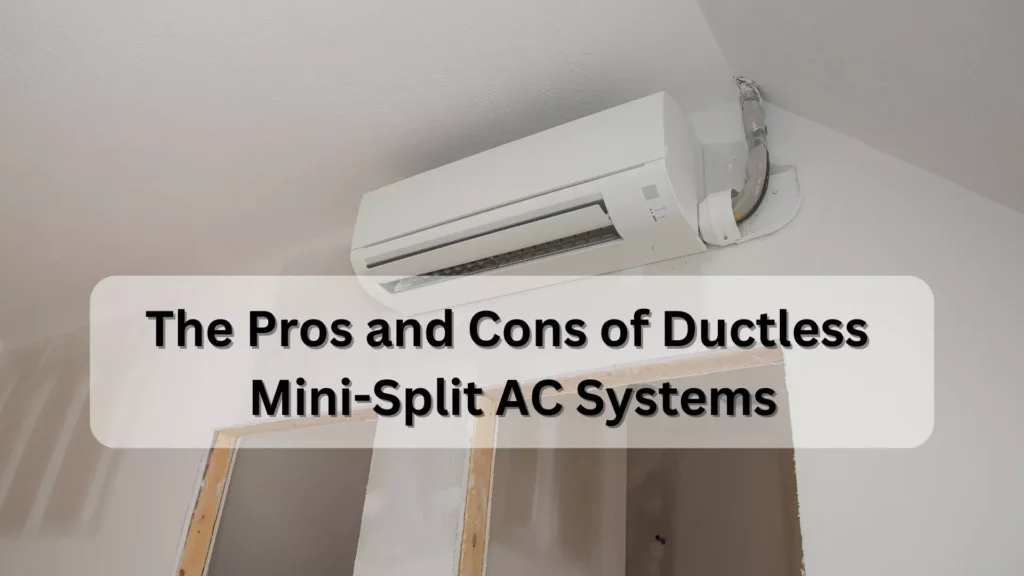
The Pros and Cons of Ductless Mini-Split AC Systems
With scorching summers becoming the norm, air conditioning is a necessity for comfort and well-being. One popular cooling solution that has gained widespread attention is the ductless mini-split AC system. Unlike traditional central air conditioning, ductless mini-splits offer a unique set of advantages and disadvantages. In this blog, we’ll explore the pros and cons of ductless mini-split AC systems to help you make an informed decision for your cooling needs.
The Pros
Energy Efficiency: Ductless mini-splits excel in energy efficiency, thanks to their inverter technology. This technology allows the compressor to adjust its speed to maintain the desired temperature, using only the necessary energy. This results in significant energy savings, making ductless systems a cost-effective option in the long run.
Zoned Cooling: One of the standout features of ductless mini-splits is their zoned cooling capabilities. Multiple indoor air handlers can be installed in different rooms or zones of your home. This zoning allows you to cool specific areas while leaving others unconditioned. Not only does this provide enhanced comfort and flexibility, but it also leads to substantial energy savings as you don’t need to cool the entire house if you’re only using specific rooms.
Easy Installation: Compared to traditional central AC systems, ductless mini-splits are relatively easy to install. They require only a small hole in the wall to connect the indoor and outdoor units. This simplicity can result in lower installation costs and less disruption to your home, making them a convenient choice.
Improved Indoor Air Quality: Ductless systems are equipped with multi-stage filtration. These filters include anti-allergen and deodorizing filters, which not only cool the air but also improve indoor air quality. By reducing allergens, dust, and odors, these systems ensure you breathe cleaner and healthier air.
Customizable and Stylish: Ductless mini-split indoor units come in various designs and can be mounted on walls, ceilings, or even recessed into the ceiling. This versatility allows you to choose units that complement your interior design. These indoor units offer a more aesthetically pleasing solution compared to traditional ducted systems, enhancing the overall ambiance of your space.
Quiet Operation: Ductless mini-split systems are known for their quiet operation. The noisy components, like the condenser and compressor, are located outside your home. This design reduces indoor noise levels, ensuring a peaceful and comfortable environment.
Increased Home Security: Ductless systems require only a small hole in the wall for installation, eliminating the need for open windows or large openings. This design enhances home security, as there are no easily accessible entry points for intruders, a common concern with window units or central air systems that require open windows.
The Cons
What is the Disadvantage of a Ductless Mini-Split System?
The disadvantages of a ductless mini-split system primarily include the upfront cost, aesthetics, limited cooling capacity, and specialized maintenance requirements. It’s essential to weigh these disadvantages against the system’s numerous benefits when deciding if it’s the right cooling solution for your home. Making an informed decision based on your specific needs and preferences ensures you enjoy efficient and comfortable cooling in your living space.
Upfront Cost: While ductless mini-splits can save you money in the long run due to their energy efficiency, the initial installation cost can be higher than that of traditional systems. However, it’s essential to consider this as an investment that can pay off through energy savings and improved comfort over time.
Aesthetics: While indoor units are customizable, some people may find them less aesthetically pleasing compared to the concealed ductwork of central systems. However, advancements in design have led to more appealing options, and many homeowners prioritize function over aesthetics.
Limited Cooling Capacity: Ductless systems are ideal for cooling individual rooms or small spaces. They might not be suitable for larger homes or those with extensive cooling needs. If you have a sprawling home with numerous rooms, a traditional central system might be more appropriate.
Maintenance: While ductless systems are generally low-maintenance, the indoor units do require some care. Periodic cleaning and filter replacement are necessary to maintain optimal performance and indoor air quality. Failing to perform these tasks can result in reduced efficiency.
Location Constraints: The installation of ductless mini-splits requires suitable wall or ceiling space for the indoor units and proper placement of the outdoor condenser unit. Limited space or architectural constraints can restrict the installation options, so careful planning is essential.
Visual Impact of Outdoor Unit: While the indoor units are sleek and compact, the outdoor condenser unit is necessary but may not be as visually appealing. Its placement may need to be carefully considered to mitigate its visual impact. Landscaping and screening options can help conceal the unit.
Long-Term Maintenance Costs: While ductless systems are often more efficient, they may require specialized maintenance or repairs that can be more expensive compared to traditional systems. It’s crucial to factor in long-term maintenance costs when considering ductless mini-splits.
Now You Can Make the Right Choice in AC
The decision to opt for a ductless mini-split AC system or a traditional central system depends on various factors, including the size of your home, your cooling requirements, budget, and personal preferences. Regardless of your choice, it’s essential to consult with a professional HVAC technician to determine the best cooling solution for your home. This expert guidance will ensure that you enjoy a comfortable and energy-efficient living environment tailored to your specific needs.

